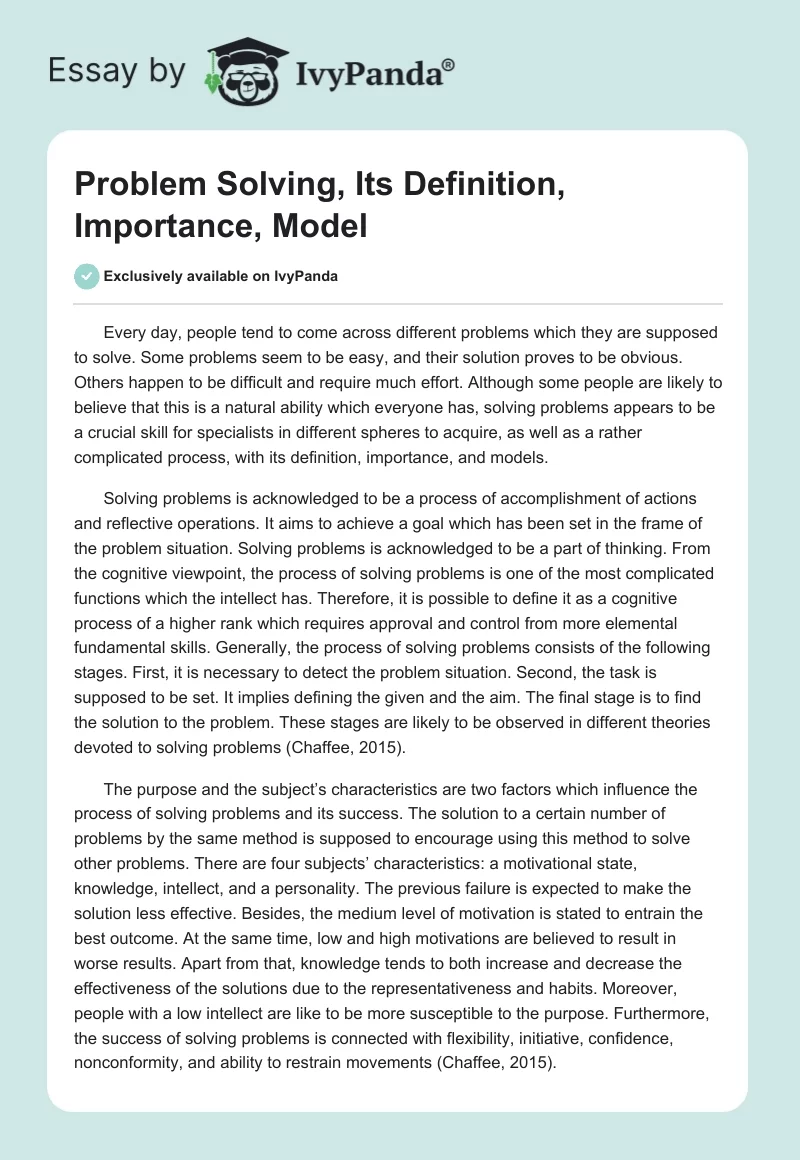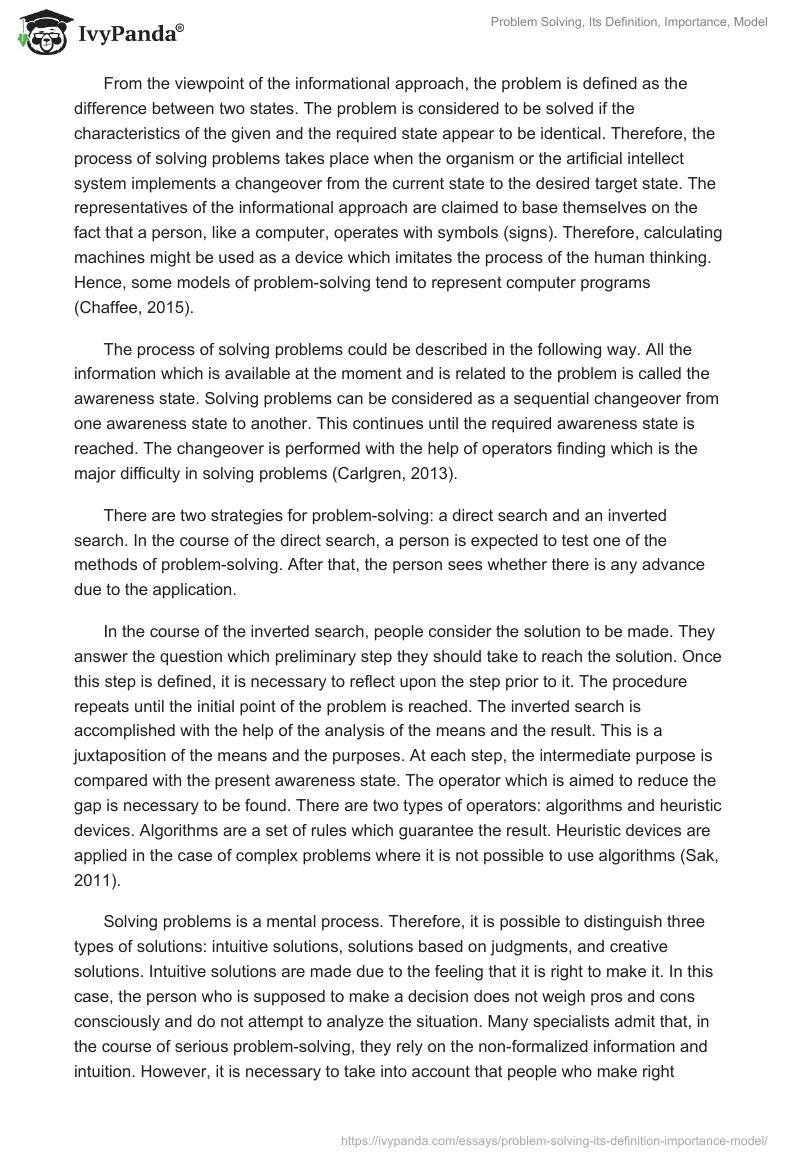Every day, people tend to come across different problems which they are supposed to solve. Some problems seem to be easy, and their solution proves to be obvious. Others happen to be difficult and require much effort. Although some people are likely to believe that this is a natural ability which everyone has, solving problems appears to be a crucial skill for specialists in different spheres to acquire, as well as a rather complicated process, with its definition, importance, and models.
Solving problems is acknowledged to be a process of accomplishment of actions and reflective operations. It aims to achieve a goal which has been set in the frame of the problem situation. Solving problems is acknowledged to be a part of thinking. From the cognitive viewpoint, the process of solving problems is one of the most complicated functions which the intellect has. Therefore, it is possible to define it as a cognitive process of a higher rank which requires approval and control from more elemental fundamental skills. Generally, the process of solving problems consists of the following stages. First, it is necessary to detect the problem situation. Second, the task is supposed to be set. It implies defining the given and the aim. The final stage is to find the solution to the problem. These stages are likely to be observed in different theories devoted to solving problems (Chaffee, 2015).
The purpose and the subject’s characteristics are two factors which influence the process of solving problems and its success. The solution to a certain number of problems by the same method is supposed to encourage using this method to solve other problems. There are four subjects’ characteristics: a motivational state, knowledge, intellect, and a personality. The previous failure is expected to make the solution less effective. Besides, the medium level of motivation is stated to entrain the best outcome. At the same time, low and high motivations are believed to result in worse results. Apart from that, knowledge tends to both increase and decrease the effectiveness of the solutions due to the representativeness and habits. Moreover, people with a low intellect are like to be more susceptible to the purpose. Furthermore, the success of solving problems is connected with flexibility, initiative, confidence, nonconformity, and ability to restrain movements (Chaffee, 2015).
From the viewpoint of the informational approach, the problem is defined as the difference between two states. The problem is considered to be solved if the characteristics of the given and the required state appear to be identical. Therefore, the process of solving problems takes place when the organism or the artificial intellect system implements a changeover from the current state to the desired target state. The representatives of the informational approach are claimed to base themselves on the fact that a person, like a computer, operates with symbols (signs). Therefore, calculating machines might be used as a device which imitates the process of the human thinking. Hence, some models of problem-solving tend to represent computer programs (Chaffee, 2015).
The process of solving problems could be described in the following way. All the information which is available at the moment and is related to the problem is called the awareness state. Solving problems can be considered as a sequential changeover from one awareness state to another. This continues until the required awareness state is reached. The changeover is performed with the help of operators finding which is the major difficulty in solving problems (Carlgren, 2013).
There are two strategies for problem-solving: a direct search and an inverted search. In the course of the direct search, a person is expected to test one of the methods of problem-solving. After that, the person sees whether there is any advance due to the application.
In the course of the inverted search, people consider the solution to be made. They answer the question which preliminary step they should take to reach the solution. Once this step is defined, it is necessary to reflect upon the step prior to it. The procedure repeats until the initial point of the problem is reached. The inverted search is accomplished with the help of the analysis of the means and the result. This is a juxtaposition of the means and the purposes. At each step, the intermediate purpose is compared with the present awareness state. The operator which is aimed to reduce the gap is necessary to be found. There are two types of operators: algorithms and heuristic devices. Algorithms are a set of rules which guarantee the result. Heuristic devices are applied in the case of complex problems where it is not possible to use algorithms (Sak, 2011).
Solving problems is a mental process. Therefore, it is possible to distinguish three types of solutions: intuitive solutions, solutions based on judgments, and creative solutions. Intuitive solutions are made due to the feeling that it is right to make it. In this case, the person who is supposed to make a decision does not weigh pros and cons consciously and do not attempt to analyze the situation. Many specialists admit that, in the course of serious problem-solving, they rely on the non-formalized information and intuition. However, it is necessary to take into account that people who make right intuitive decisions have much experience. In fact, intuition is unconsciously cumulative and processed volumes of information (Sak, 2011).
Solutions based on judgments are a conscious choice. They are based on the knowledge and experience. In this case, people juxtapose the present situation and analog situations in the past. They try to make a prognosis on the consequences of the decision to make. Normally, the alternative which was successful in the past is likely to be chosen. There are two advantages to making solutions based on judgments. First, they require mere experience and knowledge and do not take much time. Second, contrary to the intuitive approach, in this situation, it is possible to give explanations. However, there are certain drawbacks. First, it is necessary to have previous experience. Hence, in new situations, this method cannot be applied. Second, using previous experience might result in missing a great alternative which could be more effective than the variants already known and used (Sak, 2011).
Creative solutions are a complex and systematized process. It consists of a problem diagnosis, a definition of limitations, criteria for problem-solving, search for alternatives, their evaluation, and the final choice. Creative solving is based on the objective analytical process and the objective formalized method. The solution to make can be complex and large-scale. Besides, it might influence many people. So, its scientific proof gets more important. At the same time, volitional methods in its taking-up appear to be less acceptable. The major difference between creative solutions and solutions based on judgment is that the first ones do not depend on the previous experience. As already mentioned, creative problem-solving comprises the following stages: a problem diagnosis, a formulation of limitations and criteria to solve the problem, elicitation of alternatives, their evaluation, and the final decision (Sak 2011).
Thus, the first step to solving the problem is its definition or diagnosis. They should be both complete and right. The first stage in the diagnostics of a complicated matter is the establishment of the symptoms and the possibilities which are available. The realization and establishment of the symptoms help to define the problem in general. In order to discover the reasons for the problem to occur, it is necessary to collect the internal and external information. In the course of observation, it is necessary to see the difference between relevant and inappropriate information. Relevant information is the data which concerns only these specific problem, person, purpose, and time period. The problem can be of the following types: routine, crisis, and potential possibility. Routine and repeated problems are structured. Crisis and potential possibilities are unstructured. Structured problems require programmed decisions. Unstructured ones require non-programmed decisions (Sak, 2011).
The limitations are varied and depend on the situation. The number of alternatives under elaboration and consideration is stated to depend on various factors such as time, resources, information. Once the limitations are defined, it is necessary to work out criteria for alternatives to be evaluated. There are two types of criteria. They are “we must” and “we want.” In the case of “we want,” those purposes which are desirable are considered. Thus, it is not necessary to work out any alternatives. As for the criteria “we must,” it should be defined before any alternatives are considered. At the stage of the definition of alternatives, it is necessary to formulate alternatives to the solution. Frequently, they are not difficult to find. They can be standard or taken from the previous experience (Sak, 2011).
The solution to unique problems requires creative approach in the search for alternatives. Brainstorming and group analysis are used in this situation. As for the evaluation of alternatives, it is necessary to weigh pros and cons, as well as possible consequences. To juxtapose the solutions, it is necessary to use standards which have been formulated on the second stage. Based on the criteria, it is possible to evaluate potential results of the realization of each alternative. If the problem has been defined in the right way, and alternative solutions are weighed and evaluated, it is easy to make a final solution. It is necessary to choose the alternative with the most favorable outcome. It is possible to take the previous experience into account, as well as experiments, researches, and analyses (Sak, 2011).
One other issue to dwell upon in this work is ethical problems in nursing. Nurse managers should try to solve this kind of issues in medical facilities. Besides, they should encourage a good ethical attitude in the team. The range of matters which nurse managers are supposed to resolve consideration, collaboration, management, interference, individual importance, working standards, statistics and feedback, and personal issues. Nevertheless, the list is not specified. Besides, there is no algorithm how to deal with each issue. Therefore, it is necessary to elaborate an approach to solving ethical problems in nursing (Laukkanen, 2016).
In conclusion, it is necessary to point out that solving problems is a mental activity which is performed every day. There are three types of solutions: intuitive, based on judgments and creative. Creative solutions are taken based on the model described in the paper. As for solving ethical problems in nursing, a systematic approach is to be worked out. Finally, it is required to underline that solving problems is an important process.
References
Carlgren, T. (2013). Communication, critical thinking, problem solving: A suggested course for all high school students in the 21st century. Interchange, 44(1-2), 63-81.
Chaffee, J. (2015). Solving problems. In Thinking Critically (pp. 105-145). Stamford, CT: Cengage Learning.
Laukkanen, L. (2016). Solving work-related ethical problems. Nursing Ethics, 23(8), 838-850.
Sak, U. (2011). Selective problem solving (sps): A model for teaching creative problem-solving. Gifted Education International, 27(3), 349-357.


